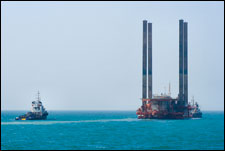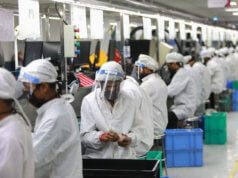 The Ministry of Petroleum and Natural Gas is optimistic that the new gas pricing formula, which comes into effect from April 1, 2014, will boost domestic and foreign investment in the oil and gas sector.
The Ministry of Petroleum and Natural Gas is optimistic that the new gas pricing formula, which comes into effect from April 1, 2014, will boost domestic and foreign investment in the oil and gas sector.
Petroleum Minister M. Veerappa Moily said as much when he emphasised the need for greater investment in this sector. Stating that his government was committed to dealing with India’s energy security issues, Moily pointed out that the gas pricing formula, based on the recommendations of the Rangarajan Committee, would encourage investor sentiment in the sector and give a fresh impetus to exploration and production of oil and gas in the country.
Investment in exploration and production has been declining from $6 billion in 2007-08 to around $1.8 billion in 2011-12. At the same time, however, Indian oil and gas companies have invested $27 billion abroad and another $10 billion is reportedly in the pipeline.
In recent times, domestic and foreign investment has been found wanting in the ninth round of NELP. As the petroleum ministry admitted in July this year, “The performance of the NELP blocks has been far from satisfactory due to a variety of reasons which is evident from the fact that out of 110 discoveries announced under NELP, only six are presently under production.”
As per the production sharing contracts signed by the government with the selected oil and gas companies, the sale of gas would take place at competitive arms length price approved by the government. Accordingly, the current price of $4.2 per mmBtu was fixed in 2009 which is applicable till March 2014 after which the new pricing formula comes into effect.
|
|||||||||||||||||||||||||||||||||||||||||
A question of viability
Since the price of $4.2 per mmBtu is not considered viable to sustain domestic production of gas, operators are seeking an increase in price. Gujarat State Petroleum Corporation Ltd, a Government of Gujarat enterprise, has been demanding a price of $13-14 per mmBtu for its blocks in KG basin. Similarly, Reliance Industries Ltd has been demanding gas price in the same range. Even public sector undertakings like ONGC Ltd and Oil India Ltd have been pushing for an increase in gas price, as production would not be viable at any price less than $7.
There are indications that under the new pricing formula, post-April 2014, the price of domestic gas could be around $8.4-8.5 per mmBtu. This price would reflect Indonesia’s gas prices which are $6-9 per mmBtu. It would, however, fall short of LNG import costs.
“We have a massive shift this year in India from gas to coal, similar to Europe. And the reasons have to do with limited domestic capacity to produce gas and high LNG prices, and the reasons for that have to do with the Indian pricing system,” Christof Ruhl, Group Chief Economist at BP, said at a presentation.
At present, the Indian energy sector is dominated by coal (nearly 60 per cent) followed by oil (25 per cent) and gas (10 per cent). The government is keen to double the share of gas by 2020.
“The rise in gas price will not only encourage the upstream companies to invest in exploring more challenging frontiers to augment gas production for the country, but a good amount of this increased price will flow back to the government in terms of royalty and dividend,” ONGC CMD Sudhir Vasudeva said in an industry statement.
Significantly, Petroleum Minister Veerappa Moily reiterated that at the current gas price of $4.2 per mmBtu, the Directorate General of Hydrocarbons had been finding gas discoveries unviable. He admitted that investment in the oil and gas sector had been declining on one hand while crude and LNG imports were growing on the other. A reversal of this trend was possible only through greater investment in exploration activities.
Investment boosters
The government has taken a number of measures to boost investment and accelerate exploration, such as allowing exploration work in mining lease areas, securing defence clearances for long pending blocks and revision of gas pricing formula. Besides, the CBM and Shale Gas policies are being finalised while work on setting up a National Data Repository has commenced.
“The administered gas pricing mechanism has been hindering the development of the natural gas sector and the availability of gas in India,” Stephanie Wilson, managing Editor – Asia LNG, Platts, said at the Commodity Week held in Mumbai recently.
Liberating the pricing mechanism would encourage investment in the natural gas sector as India still required to import LNG in spite of the increase in gas generating capacity, she added.
Today, India is the fourth largest energy consumer and the fifth largest LNG importer in the world. India and China will continue to be the biggest importers of LNG through 2035. The bulk of the country’s gas imports come from Qatar.
Other measures to secure India’s energy security include the acquisition of oil and gas assets abroad where China is offering stiff competition.“Our oil companies need to go for more aggressive acquisition to further consolidate their current asset holdings. At present, oil and gas public sector undertakings have acquired E&P assets in over 20 countries,” Moily said.
Domestic gas production in India is well short of the demand and the current deficit of 142.78 mmscmd is expected to increase to around 234.26 mmscmd in 2016-17. As a result, there will be huge dependence on import of gas at a much higher price of around $14 per mmBtu and above, which would be unaffordable for the consuming sectors. Besides, the economy can ill-afford the huge import bill of around $160 billion for petroleum products. The subsidy burden, as a result of imported LNG, could be as high as Rs. 1,20,000 crore, if the demand is not substantially met by domestic gas.
One of the main reasons for weak domestic gas production is the mismatch between production and price at which producers sell. Since the petroleum ministry also considers the current price of $4.2 per mmBtu unfeasible, it is reluctant to approve development plans for lack of commercial viability. As a result, around 3 tcf of gas reserves is waiting to be exploited.
The highest demand for gas in India is from the power and fertiliser sectors. In power sector, for instance, around 16,000 MW capacity is stranded for want of gas supply. Inadequate supply coupled with high import price as well as insufficient import infrastructure is also hampering operations in many power plants. Thus, if domestic gas supply to the power sector is not restored, the huge investment in gas-based power plants could go waste.
According to the petroleum ministry, more than 65 per cent of domestic gas production is by public sector companies and the rest is by private sector or joint venture companies between the public and private sector. Reliance Industries Ltd is currently producing only 10 per cent of gas. However, with the new pricing formula, RIL is likely to increase production from KG-D6 with additional investment. However, the gas flow is not likely to start before 2017-18 and, therefore, any gains for private sector companies at this juncture would be a misconception.
In conclusion, the Government of India feels that the revision of gas price is the “most economically prudent decision” it has taken and that it could trigger additional investment and production, reduce imports, lead to better fiscal balance, and result in affordable production by key consuming sectors like power and fertiliser.











